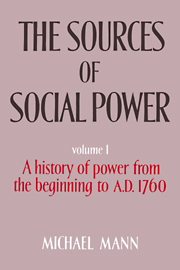Book contents
- Frontmatter
- Contents
- Preface
- 1 Societies as organized power networks
- 2 The end of general social evolution: how prehistoric peoples evaded power
- 3 The emergence of stratification, states, and multi-power-actor civilization in Mesopotamia
- 4 A comparative analysis of the emergence of stratification, states, and multi-power-actor civilizations
- 5 The first empires of domination: the dialectics of compulsory cooperation
- 6 “Indo-Europeans” and iron: expanding, diversified power networks
- 7 Phoenicians and Greeks: decentralized multi-power-actor civilizations
- 8 Revitalized empires of domination: Assyria and Persia
- 9 The Roman territorial empire
- 10 Ideology transcendent: the Christian ecumene
- 11 A comparative excursus into the world religions: Confucianism, Islam, and (especially) Hindu caste
- 12 The European dynamic: I. The intensive phase, A.D. 800–1155
- 13 The European dynamic: II. The rise of coordinating states, 1155–1477
- 14 The European dynamic: III. International capitalism and organic national states, 1477–1760
- 15 European conclusions: explaining European dynamism – capitalism, Christendom, and states
- 16 Patterns of world-historical development in agrarian societies
- Index
15 - European conclusions: explaining European dynamism – capitalism, Christendom, and states
Published online by Cambridge University Press: 26 December 2009
- Frontmatter
- Contents
- Preface
- 1 Societies as organized power networks
- 2 The end of general social evolution: how prehistoric peoples evaded power
- 3 The emergence of stratification, states, and multi-power-actor civilization in Mesopotamia
- 4 A comparative analysis of the emergence of stratification, states, and multi-power-actor civilizations
- 5 The first empires of domination: the dialectics of compulsory cooperation
- 6 “Indo-Europeans” and iron: expanding, diversified power networks
- 7 Phoenicians and Greeks: decentralized multi-power-actor civilizations
- 8 Revitalized empires of domination: Assyria and Persia
- 9 The Roman territorial empire
- 10 Ideology transcendent: the Christian ecumene
- 11 A comparative excursus into the world religions: Confucianism, Islam, and (especially) Hindu caste
- 12 The European dynamic: I. The intensive phase, A.D. 800–1155
- 13 The European dynamic: II. The rise of coordinating states, 1155–1477
- 14 The European dynamic: III. International capitalism and organic national states, 1477–1760
- 15 European conclusions: explaining European dynamism – capitalism, Christendom, and states
- 16 Patterns of world-historical development in agrarian societies
- Index
Summary
In the three preceding chapters, I narrated essentially a single story. It concerned the history of a single “society,” Europe. It also had two central themes: First, how do we explain European dynamism? Second, what have been the relationships between political and economic power organizations, between states and capitalism, in this dynamic process? We can now conclude our discussion of both themes.
The European dynamic
In the mid-twelfth century, Europe consisted of a multiple, acephalous federation of villages manors, and small states, bound loosely together by the normative pacification of Christendom. It was already the most agriculturally inventive civilization seen since the Iron Age had begun. Yet its dynamism was buried within intensive, local power networks. In extensive and in military and geopolitical terms it was not yet powerful, and it was not much noticed by the world outside. By 1815 the dynamism had exploded outward upon the world, and it was obvious that this particular civilization was the most powerful, both intensively and extensively, that the world had seen. The last three chapters described and attempted to explain this prolonged surge to power. They argued that the early agricultural dynamic within a framework of normative pacification became harnessed to three more extensive power networks: (1) capitalism; (2) the modern, organic state; and (3) a competitive, diplomatically regulated multistate civilization in which the state was embedded.
The dynamic, unlike the Industrial Revolution in which it culminated, was not sudden, discontinuous, or qualitative. It was a long-drawn-out, cumulative, and perhaps somewhat unsteady process, but nevertheless a process rather than an event, lasting for six, seven, or even eight centuries.
- Type
- Chapter
- Information
- The Sources of Social Power , pp. 500 - 517Publisher: Cambridge University PressPrint publication year: 1986



